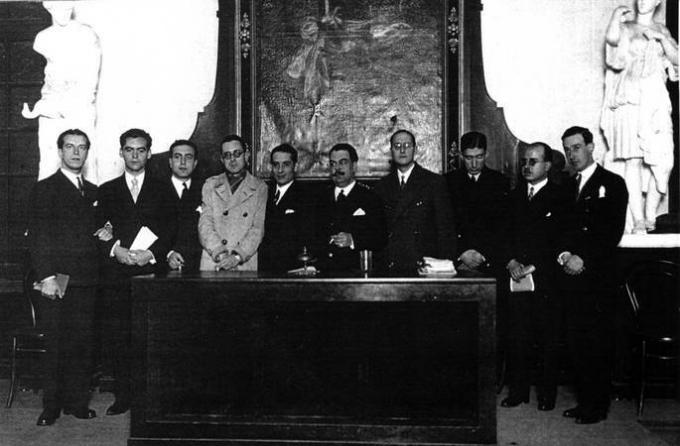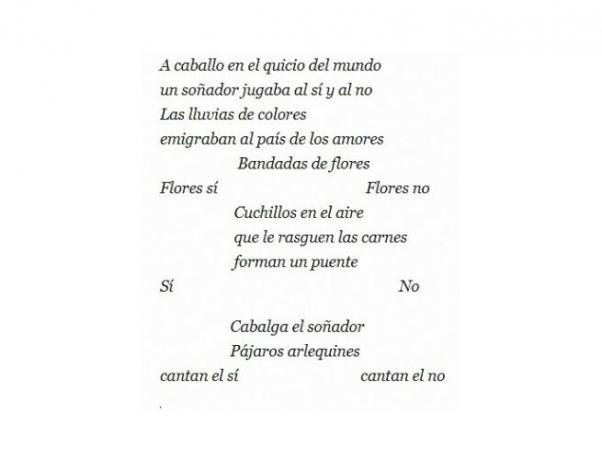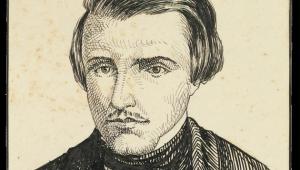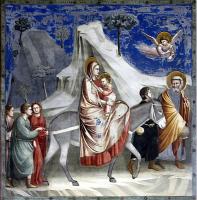Generation of 27: context, characteristics, authors and works
A group of Spanish poets and writers who began to shine in the literary scene from 1920 is called Generación del 27.
The name was assigned from the tribute that some of its members paid to Luis de Góngora in Seville for the third centenary of his death in December 1927.
This group of poets was able to assimilate the literary tradition and integrate it with the avant-garde movements in force at that time. Despite their literary differences, these poets showed similar concerns and aesthetic tastes, they also had a close relationship of friendship.
The authors traditionally associated with this generation are: Pedro Salinas, Jorge Guillén, Gerardo Diego, Dámaso Alonso, Federico García Lorca, Vicente Aleixandre, Emilio Prados, Rafael Alberti, Luis Cernuda and Manuel Altolaguirre. Although the group can be more extensive.

The Generation of '27 arises in a context of continuous social and political changes. In a few years very different events took place in the country.
First, the dictatorship of Primo de Rivera, between 1923 and 1930. This was followed by the establishment of the Second Spanish Republic in 1931. Finally, the outbreak of the Spanish Civil War in 1936, which led to the death and exile of some writers of this generation.
Let's see, below, the particularities of the poetic work of each of the authors. As well as the characteristics of one of the most important groups of poets in 20th century Spanish literature.
Main authors of the Generation of 27
Pedro Salinas (1892-1951)
The writer and poet from Madrid was the oldest of the generation of '27. Popularly known as "the poet of love", in his poetic production three stages can be distinguished.
In the first stage (1923-1932), Salinas finds great inspiration in Juan Ramón Jiménez and pure poetry, which he combines with the avant-garde. From this period, works such as Omens (1923), Random insurance (1929) and Fable and sign (1931).
With works like The voice due to you (1934), Love reason (1936) and Long regret (1939) Salinas begins his second stage (1931-1939), where he delves into love experiences.
For the poet, love is what gives meaning to the world:
I don't want to live
islands, palaces, towers.
What a high joy:
live in pronouns!Take off your suits now
the signs, the portraits,
I don't love you like this
disguised as another,
daughter always of something.
I want you pure, free,
irreducible: you.
The third stage (1939-1951) is marked by the exile of the poet. In it they stand out: The contemplated (1946), Everything clearer (1946) and Confidence (1955). It is a period where the author's commitment to reality predominates and reflects his discontent in poems such as Zero, from Everything clearer, on the threat of the atomic bomb.
Jorge Guillén (1893-1984)
This writer from Valladolid combined his career as a teacher with his poetic work, Clamor, Final and Canticle (1928), the most prominent copy of it that has four versions.
Two stages can be distinguished in his work. On the one hand, the first stageBefore the war, Guillén maintains, unlike the rest of the authors of this generation, an optimistic vision of life and the world. All his work is collected in Chant (1928), which has later editions.
In its second termAfter the war, Guillén from exile changed his way of seeing the world. He happens to have a less optimistic vision to bear witness to pain and injustice. Highlights the work Clamor published in three parts: Maremagnum (1957), That they are going to give in the sea (1960) and At the height of the circumstances (1963).
In this fragment of the poem called Extraordinary story that he wrote about the bombing of Rotterdam during World War II is one of the most representative of this stage:
And under the demonic floods,
The fury reiterated
With method,
It was achieved —almost—
Total destruction.
And minutes, months, years fell.
And I don't believe in ruins
The yellow dandelion alone,
Yellow of time,
Of a hollow time alone.
The days, the weeks rose.
And vertical, novel,
Arise the name of always.
Rotterdam is already Rotterdam.
Health!(...)
Gerardo Diego (1896-1987)
Gerardo Diego was a poet and teacher originally from Santander with a vast poetic work, which is difficult to classify by stages.
On the other hand, it can be emphasized that two tendencies coexist in his work. On the one hand, the avant-garde, which integrates ultraism and creationism, where they stand out Picture (1922) and Foam manual (1924). The author thus expressed his concept of cracionista poetry: “Believing what we did not see, they say is Faith; create what we will never see, this is Poetry ”. We see here a purely creationist poem from his collection of poems Picture:

On the other hand, the type traditional, in which the classicist metric such as the romance, the tenth or the sonnet stands out. Of this trend, titles such as Soria (1923), Human verses (1925) and Real lark (1941).
Likewise, his work stands out for its thematic variety: landscape, religion, bullfighting, music. He hardly alludes to social or political issues, except in his work Moral odes (1966).
Dámaso Alonso (1898-1990)
Professor, researcher, critic and poet from Madrid whose poetic work has two stages. The first stage, highlighted by pure poetry and is influenced by Machado and Juan Ramón Jiménez. His work predominates from this period Pure poems, city poems (1924). From which sonnets like this one stand out, with which he dispenses with ornaments and clings to simplicity:
How was it?
The door, frank.
Wine remains and smooth.
Neither matter nor spirit. Brought
and a morning light of clear day.
It wasn't about rhythm, it wasn't about harmony
nor color. The heart knows it
but say what it was like I couldn't
Because it is not form, nor does it fit in the form.
Tongue, deadly mud, inept chisel,
leaves the concept flower intact
On this clear night of my wedding
And he sings meekly, humbly,
the sensation, the shadow, the accident,
while She fills my whole soul.
The second stage, influenced by the postwar social context, stands out for one of his most important and influential works Sons of Wrath1944). Although this collection of poems, with biblical and existentialist touches, could be said to be part of the that Dámaso Alonso himself defined as rootless poetry, which is also included as poet.
Federico García Lorca (1898-1936)
Poet and playwright from Granada, Federico García Lorca is one of the greatest exponents of this generation. He was one of the most notable Spanish poets and writers of the 20th century. Two stages stand out in his poetic work:
On first stage The mixture of the traditional and popular predominates, where the influences of Juan Ramón Jiménez, Rubén Darío or Góngora are present. It is evident in this stage the tragic vision of love and death, also his inclination towards marginalized groups, to transmit injustice and frustration. At this stage, the following stand out: songs (1927) and Gypsy romance (1928).
In the second stage he breaks with the traditional to embark on surrealism, although he maintains his solidarity with the marginalized, whether they are racial or sexual.
Of this period stands out Poet in New York (1940), his most universal work, originated by a deep personal crisis. Of her highlights the use of free verse, elaborate metaphors, images and rhymes that, in reality, he uses to refer to an urban landscape full of contradictions that imprisons the human being.
This can be seen in this fragment of this surrealist poem entitled The Aurora:
The New York aurora has
four columns of silt
and a hurricane of black doves
that splash the rotten waters.
New York's aurora groans
down the huge stairs
searching between edges
tuberose of anguish drawn (...)
Vicente Aleixandre (1898-1984)
Vicente Aleixandre, originally from Seville, was a Nobel Prize winning poet in 1977. For Aleixandre “poetry is not a question of ugliness or beauty, but of maturity or communication”. Three stages can be distinguished from his poetic work.
The first stage he stands out for his pessimism, with a painful conception of man, whose desire is to return to earth and merge with nature. Man is pain and anguish.
Works such as Passion of the land (1935), with prose poems in which he approaches surrealism, Swords like lips (1932) and Destruction or love (1934), whose main theme is love that leads to pain or death.
This is reflected in poems like After Love:
Lying here, in the dim light of the room,
like the silence that remains after love,
I rise slightly from the bottom of my rest
up to your edges, dim, muted, how sweet there are.
And with my hand I review the delicate boundaries of your life
withdrawn (...)
In the second term Aleixandre abandons the surrealist current. With his work Heart story (1954), Nature ceases to be the protagonist of the poem, now it is man. He also leaves behind the pessimism of the previous stage.
To third stage works like Poems of the consummation (1968) and Knowledge dialogues (1974), where the poet explores old age from melancholy. In this period he reflects on the human condition.
Emilio Prados (1899-1962)
Emilio Prados was a Malaga poet with a copious poetic production, which can be divided into three stages.
In the first stage there are books like Weather (1925), Songs of the lighthouse keeper (1926), Return (1927), Mystery of water (1927) and Hunted body (1928), which stand out for the influence of Juan Ramón Jiménez and Andalusian neopopularism. In this first period, his impassive and contemplative posture stands out. In his verses the poet seeks the dissolution of his own body and nature.
The second term from Prados's poetic work he turns towards social and political poetry. At this stage, surrealism is evident, not only in technical resources, but also in social commitment.
The work of this stage is in three books: The underground cry (1936), Crying in the Blood (1937), Minor songbook for fighters (1938).
The third stage it coincides with his exile in Mexico. In it, poetry of great emotional intensity stands out, moved by an existential crisis in Prados. In it we can highlight books such as: Closed garden (1940), Memory of oblivion (1946), Anthology (1954) or River natural (1957). In this fragment of the poem Death and the garden you can see the characteristics of this period:
I abandoned the shape of my body;
the meat of my boredom ...
By the faithful of my eyes,
I cut the balance in two
that held me up as a living man.
Rafael Alberti (1902-1999)
Rafael Alberti was a Cadiz painter and poet. Along with García Lorca, Alberti was one of the greatest representatives of Andalusian lyricism of the 20th century. Three stages can be highlighted in his poetic work.
In the first stage stand out Sailor ashore (1925), a book of poetry with which he became known and in which traditional and popular forms are perceived. Topics such as nostalgia and longing for his homeland, where he does not reside, abound.
Of this stage also stand out The lover (1926) and The dawn of the wallflower (1927). In this fragment of his collection of poems Sailor ashore, combines tradition, simplicity and longing:
If my voice died on the ground
take it to sea level
and leave it on the bank.
Take it to sea level
and named captain
of a warship ship (...)
With the work Cal y Canto (1927), motivated by a spiritual crisis, Alberti initiates a change of tendency towards surrealism. About angels (1928) is one of his most consecrated books of his second stage, where the use of free images and the verse predominate.
The third stage de Alberti is marked by the Republic, the Civil War and exile. In it, the poet again delves into the nostalgia for the land and also highlights political poetry. Of this period, the following stand out: Sermons and mansions (1934), Between the carnation and the sword (1941) or Coplas of Juan Panadero (1949).
Luis Cernuda (1902-1963)
Luis Cernuda was a Sevillian poet and teacher whose poetic work is grouped into two stages. An existential pessimism predominates throughout his work.
In the first stageUntil the war, two books stand out: The forbidden pleasures (1931) and Where oblivion dwells (1934), in which the influence of surrealism can be appreciated.
In its second stageDuring the exile, themes such as exile, longing for childhood, loneliness or death appear. From this period, works such as Clouds (1940) and Chimera Desolation (1962). This is the excerpt from a poem called Old spring written during exile:
(...)
Alone,
with forehead in hand, a ghost
that comes back, would you cry thinking
how beautiful life was and how useless.
Manuel Altolaguirre (1905-1959)
Manuel Altolaguirre was a Malaga poet, printer and filmmaker. He was one of the youngest poets of the Generation of 27 and in his poetic work two main stages can be distinguished.
On the one hand, in the first stage, before the Civil War, stand out The invited islands (1926), Example (1927), Poetry (1931) and Solitudes together (1931).
In the second stageDuring the exile, works such as Temporary cloud (1946), marked by the tragic social context, End of a love (1949) and Poems of America (1955).
Poems with a spiritual and mystical tone predominate from this period, such as the following fragment of the poem called Separation:
I carry my loneliness inside
tower of blind windows.When my arms extend
I open your front doors
and I walk on carpeted
whoever wants to visit it.He painted the memory the pictures
that decorate their rooms.
There my past said
with my grief today they contrast (...)
In his creations the influence of Garcilaso de la Vega, Juan Ramón Jiménez or Pedro Salinas can be distinguished. In them the musicality, the short verses and classical stanzas predominate. Also themes such as love, loneliness and death.
Common features
Synthesis of tradition and avant-garde
This group of poets, as Dámaso Alonso pointed out, “does not stand up against anything”. They are interested not only in the popular and cultured lyric of the Spanish literary past, but they also opened up to the avant-garde movements that were taking place in Europe.
It can be said that his predilections were totally inclusive, from the traditional to the most current at that time, some authors pay attention to the new aesthetic currents.
Influences
The influences of this group were very diverse from modernism with Rubén Darío as a reference for some authors of this generation, going through the pure poetry of Juan Ramón Jiménez, until the vanguards.
They also look back at authors such as Garcilaso de la Vega, San Juan de la Cruz, Bécquer and Luis de Góngora.
Stylistic features
Among the stylistic features that become important in the poets of the generation of 27 are:
- Predominance of metaphor and image.
- Gradual use of free verse.
- Use of resources such as synesthesia and the symbol.
Common themes
According to Rocío Lineros Quinteros, there are four common motifs that dominate the poetry of these writers: the city, Nature, love and social commitment.
- The town, whose vision evolves from a positive treatment, as a place of progress, to a negative view, at the end of the 1920s, where the city is an adverse place for man.
- Nature. Poets frequently allude to gardens, the sea, the moon, even places in their cities of origin.
- The love seen as an experience that gives fullness and meaning to life, but also as a destructive force that leads to frustration.
- The social commitment it becomes more evident when the war begins, starting in 1936. Some exiled authors reflected their social commitment with creations of protest and denunciation.
Generational traits
The authors of the generation of 27 have an approximate age since most were born between the years 1892 and 1902. Most of them coincide at the Madrid Student Residence and receive similar intellectual training. In addition, most of the members come from the wealthy bourgeoisie and participate in literary magazines such as The Literary Gazette.
They attended the event that brought them together as a generation: a tribute to the third centenary of Góngora's death in 1927.
The Sinombrero
Generally, when referring to the generation of 27, it is usually thought of a more or less closed nucleus of male authors. Instead there was a group of contemporary thinkers, poets and artists who also belonged to this generation and contributed to social and cultural modernization, developing their work creative. These were:
- Maruja Mallo (1902-1995): painter
- Margarita Manso (1908-1960): painter
- Ángeles Santos (1911-2013): painter
- Margarita Gil Roësset (1908-1932): sculptor, illustrator and poet
- María Zambrano (1904-1991): philosopher and essayist
- María Teresa León (1903-1988): writer
- Rosa Chacel (1898-1994): writer
- Ernestina de Champourcin (1905-1999): poet
- Concha Méndez (1898-1986): writer, poet and screenwriter
References
Balló, T. (2016). The Without Hat: Without them, the story is not complete. Espasa.
Frutos, D. TO. (2010). Brief history of Spanish Literature (1st ed.). Editions Alejandría S.A.
Pardo, F. D. (2018). Brief history of the generation of 27. Nowtilus.
If you liked this article, you may also be interested in:
- Literary vanguards
- Platero y yo by Juan Ramón Jiménez



